Recipe
GOODNESS
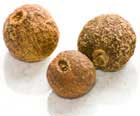 Allspice:
No, this isn't a mixture of everything in your spice rack, but rather a dried berry of the pimenta tree.
If that's a surprise to you, imagine how Columbus felt -- he thought it was pepper (thus the name pimenta,
which is Spanish for pepper). The berries look a little like plump peppercorns and the flavor is pungent,
but it is not pepper. The best allspice comes from Jamaica.
Allspice:
No, this isn't a mixture of everything in your spice rack, but rather a dried berry of the pimenta tree.
If that's a surprise to you, imagine how Columbus felt -- he thought it was pepper (thus the name pimenta,
which is Spanish for pepper). The berries look a little like plump peppercorns and the flavor is pungent,
but it is not pepper. The best allspice comes from Jamaica.For the freshest flavor, you should buy allspice in berry form and grind or crush it as needed. The taste is a pleasant mix of cloves, cinnamon and nutmeg. Used in jerks and for pickling, it goes great with meat and gives a nice kick to soups and stews. |
 Bay Leaf:
That green headband around Ceasar's head was bay, and it has a long and glorious
culinary history in Mediterranean countries.
Bay Leaf:
That green headband around Ceasar's head was bay, and it has a long and glorious
culinary history in Mediterranean countries.Bay can be bitter when fresh, so let it dry for a few days if you pluck it green from the tree. After drying, it keeps nicely in an airtight jar. It gives up its flavor slowly, which is why you add it to the beginning of slow-cooked soups and stews. It has a slightly musty aroma with shades of nutmeg that can overpower a dish, so only use half a leaf for each serving. Don't forget to pull them out before serving! |
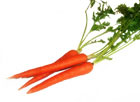 Carrots:
We all know that carrots are good for your eyes, but did you know they have anti-cancer properties as well? They have the nicely named carotenoids that are antioxidents -- chemicals that mop up the damage that results from ordinary metabolism. That, in turn, helps to keep your cells from turning rogue and hanging with the cancer gangs. If that's not enough to make you grab a carrot, they turn out to be immune-system stimulators as well, meaning you'll have fewer occasions to ask "What's up, doc?" Yes there's a little sugar in them, but also a lot of fiber to buffer it, so only the most sugar-restricted people should worry. By the way, the vitamin K in carrots is easier to absorb if you eat them with a bit of oil or fat, like a dip. Carrots:
We all know that carrots are good for your eyes, but did you know they have anti-cancer properties as well? They have the nicely named carotenoids that are antioxidents -- chemicals that mop up the damage that results from ordinary metabolism. That, in turn, helps to keep your cells from turning rogue and hanging with the cancer gangs. If that's not enough to make you grab a carrot, they turn out to be immune-system stimulators as well, meaning you'll have fewer occasions to ask "What's up, doc?" Yes there's a little sugar in them, but also a lot of fiber to buffer it, so only the most sugar-restricted people should worry. By the way, the vitamin K in carrots is easier to absorb if you eat them with a bit of oil or fat, like a dip. |
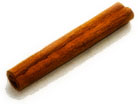 Cinnamon:
Cinnamon comes from the bark of a tropical evergreen, just like its cousin cassia. It has an ancient pedigree,
even being used to embalm a few pharaohs. That may not sound appetizing, but it has been found to be good for the heart,
the stomach and the joints. Not impressed yet? Well consider that it also seems to mimic insulin and therefore helps diabetics moderate their sugar levels. So don't be shy with this tasty and healthy spice.
Cinnamon:
Cinnamon comes from the bark of a tropical evergreen, just like its cousin cassia. It has an ancient pedigree,
even being used to embalm a few pharaohs. That may not sound appetizing, but it has been found to be good for the heart,
the stomach and the joints. Not impressed yet? Well consider that it also seems to mimic insulin and therefore helps diabetics moderate their sugar levels. So don't be shy with this tasty and healthy spice. |
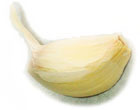 Garlic:
Garlic is in the same family as onions and leeks, and purportedly provided ancient Roman soldiers the courage to battle the barbarians.
Whether or not it gives you courage, it is known to lower blood pressure, which is great for your heart and helps prevent stroke.
In addition, it has a long history as a digestive aid, so don't be shy with this wonderful herb, no matter what it does to your breath!
Garlic:
Garlic is in the same family as onions and leeks, and purportedly provided ancient Roman soldiers the courage to battle the barbarians.
Whether or not it gives you courage, it is known to lower blood pressure, which is great for your heart and helps prevent stroke.
In addition, it has a long history as a digestive aid, so don't be shy with this wonderful herb, no matter what it does to your breath! |
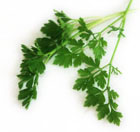 Parsley:
This refreshing herb is good for your breath and is apparently refreshing to the rest of your body. Like all green herbs, it is loaded with chlorophyll, which is just good for people. It helps you build tissue and fight inflammation. It has even been shown to help manage blood sugars and helps to keep your weight in check. More studies are needed, but it may even help to fight cancer. All that, and a breath freshener too? Who could ask for more?
Parsley:
This refreshing herb is good for your breath and is apparently refreshing to the rest of your body. Like all green herbs, it is loaded with chlorophyll, which is just good for people. It helps you build tissue and fight inflammation. It has even been shown to help manage blood sugars and helps to keep your weight in check. More studies are needed, but it may even help to fight cancer. All that, and a breath freshener too? Who could ask for more? |
ADVERTISEMENT
Help • Site Map • About Us • Contact Us • Privacy Policy • Press Center
Spice Plan™ Copyright © 2009 by Scott Charles Anderson. All rights reserved.